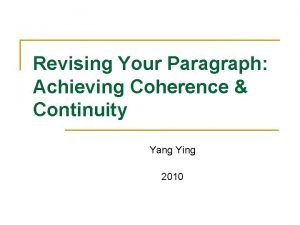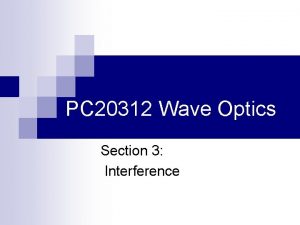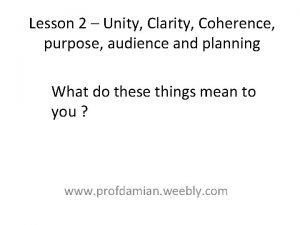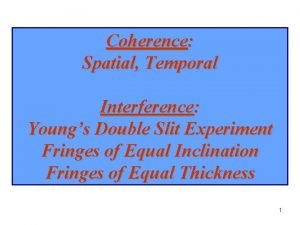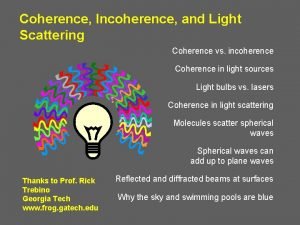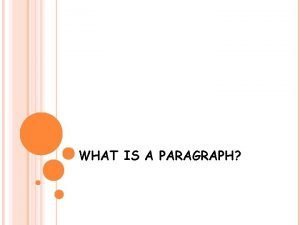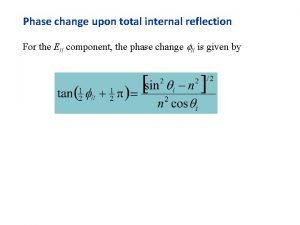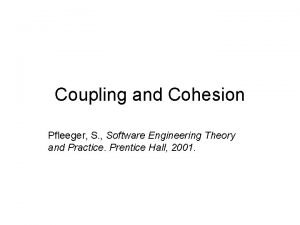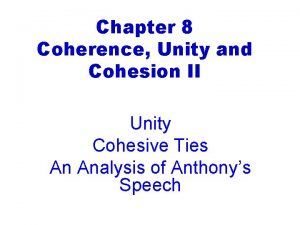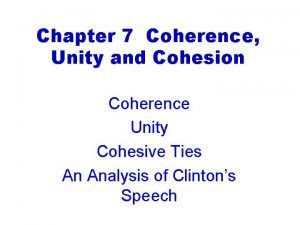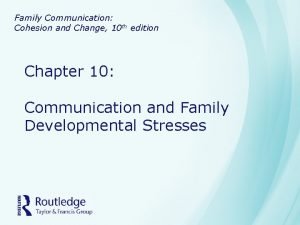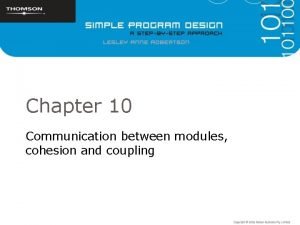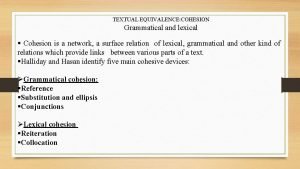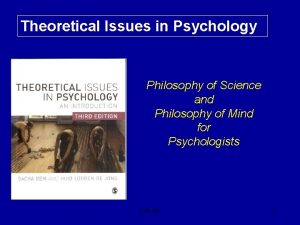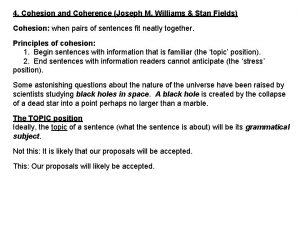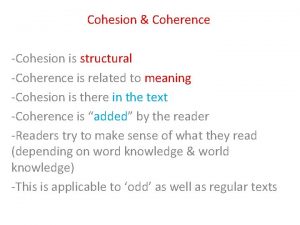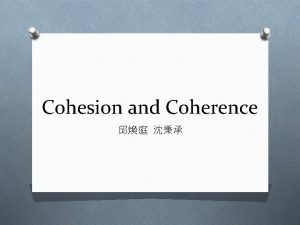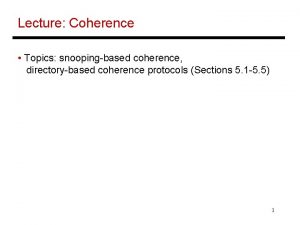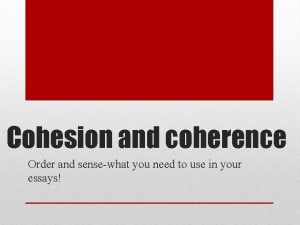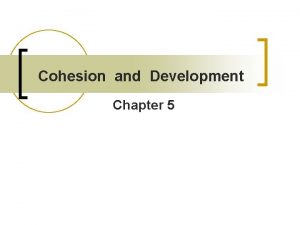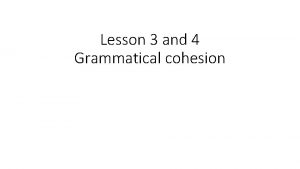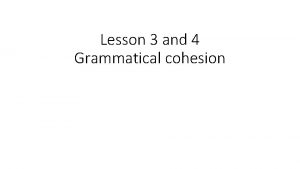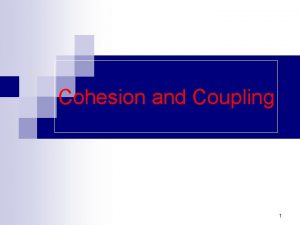5 Cohesion and Coherence Joseph M Williams Stan









































- Slides: 41

5. Cohesion and Coherence (Joseph M. Williams & Stan Fields) Cohesion: when pairs of sentences fit neatly together. Principles of cohesion: 1. Begin sentences with information that is familiar (the ‘topic’ position). 2. End sentences with information readers cannot anticipate (the ‘stress’ position). Some astonishing questions about the nature of the universe have been raised by scientists studying black holes in space. A black hole is created by the collapse of a dead star into a point perhaps no larger than a marble. The TOPIC position Ideally, the Topic of a sentence (what the sentence is about) will be its grammatical subject. Not this: It is likely that our proposals will be accepted. This: Our proposals will likely be accepted. Coherence: when all of the individual sentences in a passage support a larger point or claim. Principle of coherence: The topics of each sentence in the passage should constitute a relatively small set of related ideas.

5. Cohesion and Coherence (Joseph M. Williams & Stan Fields) Cohesion: when pairs of sentences fit neatly together. Principles of cohesion: 1. Begin sentences with information that is familiar (the ‘topic’ position). 2. End sentences with information readers cannot anticipate (the ‘stress’ position). Some astonishing questions about the nature of the universe have been raised by scientists studying black holes in space. A black hole is created by the collapse of a dead star into a point perhaps no larger than a marble. The TOPIC position Ideally, the Topic of a sentence (what the sentence is about) will be its grammatical subject. Not this: It is likely that our proposals will be accepted. This: Our proposals will likely be accepted. Coherence: when all of the individual sentences in a passage support a larger point or claim. Principle of coherence: The topics of each sentence in the passage should constitute a relatively small set of related ideas.

5. Cohesion and Coherence (Joseph M. Williams & Stan Fields) Cohesion: when pairs of sentences fit neatly together. Principles of cohesion: 1. Begin sentences with information that is familiar (the ‘topic’ position). 2. End sentences with information readers cannot anticipate (the ‘stress’ position). Some astonishing questions about the nature of the universe have been raised by scientists studying black holes in space. A black hole is created by the collapse of a dead star into a point perhaps no larger than a marble. The TOPIC position Ideally, the Topic of a sentence (what the sentence is about) will be its grammatical subject. Not this: It is likely that our proposals will be accepted. This: Our proposals will likely be accepted. Coherence: when all of the individual sentences in a passage support a larger point or claim. Principle of coherence: The topics of each sentence in the passage should constitute a relatively small set of related ideas.

5. Cohesion and Coherence (Joseph M. Williams & Stan Fields) Cohesion: when pairs of sentences fit neatly together. Principles of cohesion: 1. Begin sentences with information that is familiar (the ‘topic’ position). 2. End sentences with information readers cannot anticipate (the ‘stress’ position). Some astonishing questions about the nature of the universe have been raised by scientists studying black holes in space. A black hole is created by the collapse of a dead star into a point perhaps no larger than a marble. The TOPIC position Ideally, the Topic of a sentence (what the sentence is about) will be its grammatical subject. Not this: It is likely that our proposals will be accepted. This: Our proposals will likely be accepted. Coherence: when all of the individual sentences in a passage support a larger point or claim. Principle of coherence: The topics of each sentence in the passage should constitute a relatively small set of related ideas.

Are the sentences in the following passages cohesive? Are the passages coherent? Saynor, Wisconsin, is the snowmobile capital of the world. The buzzing of snowmobile engines fills the air, and their tanklike tracks crisscross the snow. The snow reminds me of mom’s mashed potatoes, covered with furrows I would draw with my fork. Her mashed potatoes usually make me sick, that’s why I play with them. I like to make a hole in the middle of the potatoes and fill it with melted butter. This behavior has been the subject of long chats between me and my analyst.

Are the sentences in the following passages cohesive? Are the passages coherent? Hypophysectomy (surgical removal of the pituitary) dramatically reduces circulating growth hormone (GH), insulin-like growth factor-1 (IGF-1), and thyroid hormones, and can extend life span in rats; these effects are similar to those of the Snell and Ames dwarf mutations in mice, which genetically ablate these pituitary hormones. Dwarf mice out-live normal controls and dwarfs exhibit many forestalled phenotypes of aging. But because these mutations confer lifelong hormonal deficits that slow growth, alter development and prevent reproduction, the relationship of these models to normal mammalian aging has been questioned. Furthermore, if the life span extension of dwarf mice is dependent on developmental abnormalities (especially at the expense of fecundity), clinical relevance of these models is limited. This interplay between development and aging is difficult to assess in mutant dwarf mice; however, age-specific effects can be defined in normal mice using hypophysectomy.

Are the sentences in the following passages cohesive? Are the passages coherent? Hypophysectomy (surgical removal of the pituitary) dramatically reduces circulating growth hormone (GH), insulin-like growth factor-1 (IGF-1), and thyroid hormones, and can extend life span in rats; these effects are similar to those of the Snell and Ames dwarf mutations in mice, which genetically ablate these pituitary hormones. Dwarf mice out-live normal controls and dwarfs exhibit many forestalled phenotypes of aging. But because these mutations confer lifelong hormonal deficits that slow growth, alter development and prevent reproduction, the relationship of these models to normal mammalian aging has been questioned. Furthermore, if the life span extension of dwarf mice is dependent on developmental abnormalities (especially at the expense of fecundity), clinical relevance of these models is limited. This interplay between development and aging is difficult to assess in mutant dwarf mice; however, age-specific effects can be defined in normal mice using hypophysectomy. Subjects/topics

Are the sentences in the following passages cohesive? Are the passages coherent? Hypophysectomy (surgical removal of the pituitary) dramatically reduces circulating growth hormone (GH), insulin-like growth factor-1 (IGF-1), and thyroid hormones, and can extend life span in rats; these effects are similar to those of the Snell and Ames dwarf mutations in mice, which genetically ablate these pituitary hormones. Dwarf mice out-live normal controls and dwarfs exhibit many forestalled phenotypes of aging. But because these mutations confer lifelong hormonal deficits that slow growth, alter development and prevent reproduction, the relationship of these models to normal mammalian aging has been questioned. Furthermore, if the life span extension of dwarf mice is dependent on developmental abnormalities (especially at the expense of fecundity), clinical relevance of these models is limited. This interplay between development and aging is difficult to assess in mutant dwarf mice; however, age-specific effects can be defined in normal mice using hypophysectomy. Subjects/topics The surgical removal of the pituitary, known as hypophysectomy, dramatically reduces circulating growth hormone (GH), insulin-like growth factor-1 (IGF-1), and thyroid hormones, and can extend life span in rats; its effects are similar to those of the mouse Snell and Ames dwarf mutations, which genetically ablate these pituitary hormones. The Dwarf mutations result in mice that out-live normal controls and exhibit many forestalled phenotypes of aging. But these mutations confer lifelong hormonal deficits that slow growth, alter development and prevent reproduction, and thus the mutant mice may be a poor model for mammalian aging. Furthermore, if the dwarf mice live longer solely because of developmental abnormalities and reduced fecundity, their relevance to clinical studies is especially limited. Thus, dwarf mice are not useful to assess the interplay between development and aging, whereas normal mice that have undergone hypophysectomy permit age-specific effects to be defined.

Diagnosing your own writing: 1. Do the first seven or eight words of every sentence (and clause) constitute a relatively small set of related ideas? 2. Do those words name your most important characters? 3. Are the topics of those sentences the grammatical subjects? Is a sequence of identical topics in a passage monotonous?

Diagnosing your own writing: 1. Do the first seven or eight words of every sentence (and clause) constitute a relatively small set of related ideas? 2. Do those words name your most important characters? 3. Are the topics of those sentences the grammatical subjects? Is a sequence of identical topics in a passage monotonous? Probably not for the reader (in many instances). For the sake of clarity, it is often better to err on the side of consistency, than variety.

Diagnosing your own writing: 1. Do the first seven or eight words of every sentence (and clause) constitute a relatively small set of related ideas? 2. Do those words name your most important characters? 3. Are the topics of those sentences the grammatical subjects? Is a sequence of identical topics in a passage monotonous? Probably not for the reader (in many instances). For the sake of clarity, it is often better to err on the side of consistency, than variety. Some astonishing questions about the nature of the universe have been raised by scientists studying black holes in space. A black hole is created by the collapse of a dead star into a point perhaps no larger than a marble. So much matter compressed into so little volume changes the fabric of space around it in puzzling ways. The next sentence in the above passage could begin with a new but familiar term: Astronomers have recently reported, for example, that…

The STRESS position Readers want the Stress position (the last few words of a sentence or passage) to communicate: i. Long and complex phrases: Not this: A sociometric and actuarial analysis of Social Security revenues and disbursements for the last six decades to determine changes in projecting deficits is the subject of this study. This: In this study, we analyze Social Security’s revenues and disbursements for the last six decades, using sociometric and actuarial criteria to determine changes in projecting deficits. ii. New information, particularly unfamiliar technical terms: Not this: lympokine-activated killer (LAK) cells are lymphoid cells that can lyse fresh, noncultured, naturalkiller-cell-resistant tumor cells but normal cells and are produced by incubating lymphocytes with the lympokine, interleukin-2. This: The incubation of peripheral-blood lymphocytes with a lympokine, interleukin-2, generates lymphoid cells that can lyse fresh, noncultured, natural-killer-cell-resistant tumor cells but normal cells. We term these cells lympokine-activated killer (LAK) cells.

iii. Emphasis (the significant information in the sentence): Some ways to manage endings for emphasis: A. Trim the end. Some sociobiologists claim that our genes control our social behavior in the way we act in situations we are in every day.

iii. Emphasis (the significant information in the sentence): Some ways to manage endings for emphasis: A. Trim the end. Some sociobiologists claim that our genes control our social behavior in the way we act in situations we are in every day.

iii. Emphasis (the significant information in the sentence): Some ways to manage endings for emphasis: A. Trim the end. Some sociobiologists claim that our genes control our social behavior.

iii. Emphasis (the significant information in the sentence): Some ways to manage endings for emphasis: A. Trim the end. Some sociobiologists claim that our genes control our social behavior. B. Shift peripheral ideas to the left. The data offered to prove ESP are too weak for the most part.

iii. Emphasis (the significant information in the sentence): Some ways to manage endings for emphasis: A. Trim the end. Some sociobiologists claim that our genes control our social behavior. B. Shift peripheral ideas to the left. The data offered to prove ESP are too weak for the most part.

iii. Emphasis (the significant information in the sentence): Some ways to manage endings for emphasis: A. Trim the end. Some sociobiologists claim that our genes control our social behavior. B. Shift peripheral ideas to the left. The data offered to prove ESP are too weak for the most part. For the most part, the data offered to prove ESP are too weak.

iii. Emphasis (the significant information in the sentence): Some ways to manage endings for emphasis: A. Trim the end. Some sociobiologists claim that our genes control our social behavior. B. Shift peripheral ideas to the left. The data offered to prove ESP are too weak for the most part. For the most part, the data offered to prove ESP are too weak. Sentences are cohesive with one another when we see at the beginning of a second sentence information that appeared toward the end of the preceding sentence.

iii. Emphasis (the significant information in the sentence): Some ways to manage endings for emphasis: A. Trim the end. Some sociobiologists claim that our genes control our social behavior. B. Shift peripheral ideas to the left. The data offered to prove ESP are too weak for the most part. For the most part, the data offered to prove ESP are too weak. Sentences are cohesive with one another when we see at the beginning of a second sentence information that appeared toward the end of the preceding sentence. ÞPassages are coherent when we see that the topics of each sentence in the passage constitute a relatively small set of related ideas.

iii. Emphasis (the significant information in the sentence): Some ways to manage endings for emphasis: A. Trim the end. Some sociobiologists claim that our genes control our social behavior. B. Shift peripheral ideas to the left. The data offered to prove ESP are too weak for the most part. For the most part, the data offered to prove ESP are too weak. Sentences are cohesive with one another when we see at the beginning of a second sentence information that appeared toward the end of the preceding sentence. ÞPassages are coherent when we see that the topics of each sentence in the passage constitute a relatively small set of related ideas. From last weeks class… ÞIn a clear sentence, the main characters (flesh and blood or abstract) are subjects and most of the verbs name the actions of the characters.

iii. Emphasis (the significant information in the sentence): Some ways to manage endings for emphasis: A. Trim the end. Some sociobiologists claim that our genes control our social behavior. B. Shift peripheral ideas to the left. The data offered to prove ESP are too weak for the most part. For the most part, the data offered to prove ESP are too weak. Sentences are cohesive with one another when we see at the beginning of a second sentence information that appeared toward the end of the preceding sentence. ÞPassages are coherent when we see that the topics of each sentence in the passage constitute a relatively small set of related ideas. From last weeks class… ÞIn a clear sentence, the main characters (flesh and blood or abstract) are subjects and most of the verbs name the actions of the characters. (ideally, the Topic of a sentence (what the sentence is about) will be its grammatical subject)

7. Parallel Structure (http: //faculty. washington. edu/ezent/imsc. htm, Michael Alley & Robert A. Day) The parallel structure of a sentence refers to the extent to which different parts of the sentence match each other in form. In a series, all of the items should be alike, whether all nouns, all gerunds, all phrases or all clauses. If a series of verbs is used, they should all be in the same tense, voice and mood Examples: The process involves three steps: Cooling, chopping and pulverization.

7. Parallel Structure (http: //faculty. washington. edu/ezent/imsc. htm, Michael Alley & Robert A. Day) The parallel structure of a sentence refers to the extent to which different parts of the sentence match each other in form. In a series, all of the items should be alike, whether all nouns, all gerunds, all phrases or all clauses. If a series of verbs is used, they should all be in the same tense, voice and mood Examples: The process involves three steps: Cooling, chopping and pulverization. “Cooling” and “chopping” are gerunds, but “pulverization” is a nominalization. Change to: The process involves three steps: Cooling, chopping and pulverizing.

7. Parallel Structure (http: //faculty. washington. edu/ezent/imsc. htm, Michael Alley & Robert A. Day) The parallel structure of a sentence refers to the extent to which different parts of the sentence match each other in form. In a series, all of the items should be alike, whether all nouns, all gerunds, all phrases or all clauses. If a series of verbs is used, they should all be in the same tense, voice and mood Examples: The process involves three steps: Cooling, chopping and pulverization. “Cooling” and “chopping” are gerunds, but “pulverization” is a nominalization. Change to: The process involves three steps: Cooling, chopping and pulverizing. In the last minute of the game, John intercepted the football, evaded the tacklers, and a touchdown was scored.

7. Parallel Structure (http: //faculty. washington. edu/ezent/imsc. htm, Michael Alley & Robert A. Day) The parallel structure of a sentence refers to the extent to which different parts of the sentence match each other in form. In a series, all of the items should be alike, whether all nouns, all gerunds, all phrases or all clauses. If a series of verbs is used, they should all be in the same tense, voice and mood Examples: The process involves three steps: Cooling, chopping and pulverization. “Cooling” and “chopping” are gerunds, but “pulverization” is a nominalization. Change to: The process involves three steps: Cooling, chopping and pulverizing. In the last minute of the game, John intercepted the football, evaded the tacklers, and a touchdown was scored. The first two phrases in this sentence are in the active voice: "intercepted the football" and "evaded the tacklers. " However, the final phrase is in the passive voice: "and a touchdown was scored. ” Change to: In the last minute of the game, John intercepted the football, evaded the tacklers, and scored a touchdown.

7. Parallel Structure (http: //faculty. washington. edu/ezent/imsc. htm, Michael Alley & Robert A. Day) The parallel structure of a sentence refers to the extent to which different parts of the sentence match each other in form. In a series, all of the items should be alike, whether all nouns, all gerunds, all phrases or all clauses. If a series of verbs is used, they should all be in the same tense, voice and mood Examples: The process involves three steps: Cooling, chopping and pulverization. “Cooling” and “chopping” are gerunds, but “pulverization” is a nominalization. Change to: The process involves three steps: Cooling, chopping and pulverizing. In the last minute of the game, John intercepted the football, evaded the tacklers, and a touchdown was scored. The first two phrases in this sentence are in the active voice: "intercepted the football" and "evaded the tacklers. " However, the final phrase is in the passive voice: "and a touchdown was scored. ” Change to: In the last minute of the game, John intercepted the football, evaded the tacklers, and scored a touchdown. The new coach is a smart strategist, an effective manager, and works hard.

7. Parallel Structure (http: //faculty. washington. edu/ezent/imsc. htm, Michael Alley & Robert A. Day) The parallel structure of a sentence refers to the extent to which different parts of the sentence match each other in form. In a series, all of the items should be alike, whether all nouns, all gerunds, all phrases or all clauses. If a series of verbs is used, they should all be in the same tense, voice and mood Examples: The process involves three steps: Cooling, chopping and pulverization. “Cooling” and “chopping” are gerunds, but “pulverization” is a nominalization. Change to: The process involves three steps: Cooling, chopping and pulverizing. In the last minute of the game, John intercepted the football, evaded the tacklers, and a touchdown was scored. The first two phrases in this sentence are in the active voice: "intercepted the football" and "evaded the tacklers. " However, the final phrase is in the passive voice: "and a touchdown was scored. ” Change to: In the last minute of the game, John intercepted the football, evaded the tacklers, and scored a touchdown. The new coach is a smart strategist, an effective manager, and works hard. "A smart strategist" and "an effective manager" are consistent with one another in form, but not consistent with "works hard. " Change to: The new coach is a smart strategist, an effective manager, and a hard worker.

8. Subject Verb agreement (http: //www. ucalgary. ca/Uof. C/eduweb/grammar/) General Rule: When the subject of the sentence is singular, the verb must be singular; when the subject of the sentence is plural, the verb must be plural. Ignore words, phrases or clauses between the subject and the verb.

8. Subject Verb agreement (http: //www. ucalgary. ca/Uof. C/eduweb/grammar/) General Rule: When the subject of the sentence is singular, the verb must be singular; when the subject of the sentence is plural, the verb must be plural. Ignore words, phrases or clauses between the subject and the verb. Examples: One man out of five uses an after shave.

8. Subject Verb agreement (http: //www. ucalgary. ca/Uof. C/eduweb/grammar/) General Rule: When the subject of the sentence is singular, the verb must be singular; when the subject of the sentence is plural, the verb must be plural. Ignore words, phrases or clauses between the subject and the verb. Examples: One man out of five uses an after shave.

8. Subject Verb agreement (http: //www. ucalgary. ca/Uof. C/eduweb/grammar/) General Rule: When the subject of the sentence is singular, the verb must be singular; when the subject of the sentence is plural, the verb must be plural. Ignore words, phrases or clauses between the subject and the verb. Examples: One man out of five uses an after shave. A collective noun may be either SINGULAR or PLURAL depending on whether you mean the individuals or the group: The group is united on the subject of abortion. The group, all ten of them, have different opinions. Little Women is a novel of great sentimentality.

8. Subject Verb agreement (http: //www. ucalgary. ca/Uof. C/eduweb/grammar/) General Rule: When the subject of the sentence is singular, the verb must be singular; when the subject of the sentence is plural, the verb must be plural. Ignore words, phrases or clauses between the subject and the verb. Examples: One man out of five uses an after shave. A collective noun may be either SINGULAR or PLURAL depending on whether you mean the individuals or the group: The group is united on the subject of abortion. The group, all ten of them, have different opinions. Little Women is a novel of great sentimentality. When the conjunction "and" joins two or more subjects (whether singular or plural) the verb must be PLURAL: The boy and his sister go to the same school.

8. Subject Verb agreement (http: //www. ucalgary. ca/Uof. C/eduweb/grammar/) General Rule: When the subject of the sentence is singular, the verb must be singular; when the subject of the sentence is plural, the verb must be plural. Ignore words, phrases or clauses between the subject and the verb. Examples: One man out of five uses an after shave. A collective noun may be either SINGULAR or PLURAL depending on whether you mean the individuals or the group: The group is united on the subject of abortion. The group, all ten of them, have different opinions. Little Women is a novel of great sentimentality. When the conjunction "and" joins two or more subjects (whether singular or plural) the verb must be PLURAL: The boy and his sister go to the same school. If "either/or" or "neither/nor" joins two subjects, the verb agrees in number with the nearer SUBJECT: Neither my mother nor her friends attend the class. Either oranges or a lemon is used in that recipe.

The indefinite pronouns another, each, either, none and neither as well as those ending in -one, body, -thing are always singular and take a singular verb: Each of my friends feels sorry for my plight. None of us knows the answer to the question.

The indefinite pronouns another, each, either, none and neither as well as those ending in -one, body, -thing are always singular and take a singular verb: Each of my friends feels sorry for my plight. None of us knows the answer to the question. The definite pronouns all, any, most, more, and some take a singular verb if they refer to a singular portion of a whole or a plural verb if they refer to more than one: Some of the cake remains on the plate for you. Some of my schoolmates like to dance all night.

9. Pronoun ambiguity (Michael Alley) Examples: Because the receiver presented the radiometer with a high-flux environment, it was mounted in a silver-plated stainless steel container.

9. Pronoun ambiguity (Michael Alley) Examples: Because the receiver presented the radiometer with a high-flux environment, it was mounted in a silver-plated stainless steel container. What is mounted in the container: the receiver? the radiometer? the high-flux environment?

9. Pronoun ambiguity (Michael Alley) Examples: Because the receiver presented the radiometer with a high-flux environment, it was mounted in a silver-plated stainless steel container. What is mounted in the container: the receiver? the radiometer? the high-flux environment? There are no peaks in the olefinic region. Therefore, no significant concentration of olefinic hydrocarbons exist in fresh oil. This places an upper limit on the concentration of olefins, no more than 0. 01 percent…

9. Pronoun ambiguity (Michael Alley) Examples: Because the receiver presented the radiometer with a high-flux environment, it was mounted in a silver-plated stainless steel container. What is mounted in the container: the receiver? the radiometer? the high-flux environment? There are no peaks in the olefinic region. Therefore, no significant concentration of olefinic hydrocarbons exist in fresh oil. This places an upper limit on the concentration of olefins, no more than 0. 01 percent… What does “This” refer to: the noun at the end of the preceding sentence (fresh oil)? the subject of the preceding sentence (no significant concentration of olefinic hydrocarbons)? the first sentence in this passage (…no peaks in the olefinic region)?

9. Pronoun ambiguity (Michael Alley) Examples: Because the receiver presented the radiometer with a high-flux environment, it was mounted in a silver-plated stainless steel container. What is mounted in the container: the receiver? the radiometer? the high-flux environment? There are no peaks in the olefinic region. Therefore, no significant concentration of olefinic hydrocarbons exist in fresh oil. This places an upper limit on the concentration of olefins, no more than 0. 01 percent… What does “This” refer to: the noun at the end of the preceding sentence (fresh oil)? the subject of the preceding sentence (no significant concentration of olefinic hydrocarbons)? the first sentence in this passage (…no peaks in the olefinic region)? “This” was actually intended to refer to the lack of peaks in the olefinic region. Change to: The chromatogram has no peaks in the olefinic region. Therefore, no significant concentration of olefinic hydrocarbons exist in fresh oil. This chromatogram finding places an upper limit on the concentration of olefins, no more than 0. 01 percent…
 What is unity in paragraph
What is unity in paragraph Cohesion and coherence
Cohesion and coherence What is cohesion and coherence
What is cohesion and coherence Example of cohesion
Example of cohesion Cohesion and coherence
Cohesion and coherence Define coherence and cohesion
Define coherence and cohesion Example of coherence and cohesion
Example of coherence and cohesion Discourse analysis definition in linguistics
Discourse analysis definition in linguistics Sam and verna williams
Sam and verna williams Andy williams robert williams
Andy williams robert williams Robbie williams janet williams
Robbie williams janet williams Unity vs coherence
Unity vs coherence Tagxedo about unity and coherence
Tagxedo about unity and coherence What is temporal and spatial coherence
What is temporal and spatial coherence Coherence vs unity
Coherence vs unity Coherence vs clarity
Coherence vs clarity What is temporal and spatial coherence
What is temporal and spatial coherence V number in optical fiber
V number in optical fiber Unity or sticking togetherness
Unity or sticking togetherness Narrative coherence and fidelity examples
Narrative coherence and fidelity examples Narrative fidelity meaning
Narrative fidelity meaning Fuat sungur
Fuat sungur Unity and coherence
Unity and coherence Scattering of light
Scattering of light Example of paragraph
Example of paragraph General subject example
General subject example Temporal and spatial coherence
Temporal and spatial coherence Focus and coherence
Focus and coherence Emc unity snapshot
Emc unity snapshot Discrete fourier transform formula
Discrete fourier transform formula Family trauma
Family trauma What are cohesive forces
What are cohesive forces Functional cohesion example
Functional cohesion example Cohesion in writing
Cohesion in writing Water molecule
Water molecule Unity and cohesion
Unity and cohesion Unity and cohesion
Unity and cohesion Family communication cohesion and change 10th edition
Family communication cohesion and change 10th edition Communicational cohesion
Communicational cohesion Textual equivalence
Textual equivalence Transition words for 6th graders
Transition words for 6th graders Coherence theory of truth
Coherence theory of truth






